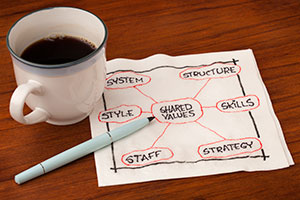 You never know when you’ll experience an ah-ha moment that transcends the original application.
You never know when you’ll experience an ah-ha moment that transcends the original application.
Two members of our team recently experienced one of those moments while attending a performance of BodyVox, an internationally touring dance company based in Portland. While reflecting on the unfortunate lack of appreciation and support for liberal arts in the education system, Jamey Hampton, BodyVox co-founder and co-artistic director, commented. “We can’t say it’s a cultural problem. We ARE the culture.”
“Ah-ha,” we said. There are no spectators when it comes to culture (both within the organizational context and beyond). Everyone plays a role, and the role leaders play is particularly impactful and should never be underestimated. If there’s a problem with the organizational culture, then every leader has a responsibility to identify it, shine a spotlight on it, and identify a way to fix it.
The challenge is that organizational culture may seem like an unruly beast that is impossible to tame. This couldn’t be further from the truth. A number of factors influence culture, and each one can be altered to create a stronger alignment between our current state and the one to which we aspire. Let’s explore three main contributing factors:
- People. Naturally, the values of senior leaders define the organizational culture to a large extent, especially for start-ups. They’re the most prominent voices and set the tone for what behaviors are accepted and rewarded. Beyond the founders/senior leaders, each additional new hire contributes to either reinforcing the culture or forcing an evolution. The larger an organization becomes, the more likely there are subcultures defined by common values of a smaller group. The extent to which a hiring manager hires people who think/act like him/her vs. a hiring manager who seeks out diverse perspectives will influence the strength of the culture. Personality in aggregate becomes culture, so if you only hire aggressive individuals with a high work focus and drive to succeed, then suddenly the culture may become one of competition and demanding work hours. Pay attention to the behaviors exhibited by senior leaders and the signals they leave regarding the company culture. Be mindful of the impact each new employee will have on the shape of the company culture going forward.
- Policies. Ensure that the policies of the organization align with the stated values. Many of the most successful Silicon Valley tech founders have been quoted as saying they hire smart, responsible people and then give them the freedom to go be awesome. This mentality of supporting autonomy would be completely destroyed by policies that undermine the culture. Having employees clock in for rigid hours, creating bureaucratic policies, and defining hierarchical lines of approval are a few ways policies can erode the best laid plans for a unique culture.
- Rewards. Finally, be mindful of the behaviors that are rewarded within the culture. For example, many women report they feel pressured to work long, unrealistic hours because those who are present after-hours are perceived to be the most committed to the organization. They’re rewarded with pats on the back for their extra effort and often given special projects. Rewarding those who work the longest hours may unintentionally result in women (particularly those with families) receiving fewer opportunities for recognition and advancement. In addition, it’s important to question if the behavior is really worth rewarding. Perhaps the extra work hours are unnecessary and there’s a failure to reward productivity and efficiency vs. total hours worked.
For each of the contributing factors above, each individual in the organization can play a powerful role in helping evolve the culture to a more ideal state. Taking an active role in defining the right culture for the organization and ensuring the people and policies align with the organization’s values is everyone’s responsibility.
For more information on building an effective organizational culture, click here.
